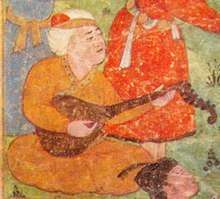Barbad
Barbad (Persian: بربد) or Barbad-ī Marvazi[1] (Persian: باربد جهرمی / باربد / باربذ) was a Persian musician of the Sassanid era, who lived during the rule of Khosrau II, 590 to 628.[2]
Barbad | |
|---|---|
 Artwork depicting Barbad (dated 1664) | |
| Born | Unknown |
| Died | 628 |
| Occupation | Musician |
Etymology
The name is the Arabicized pronunciation of the Persian name Pahlbod, which is most probably how he was called in his own day.
Life
In most sources, Jahrom a small city south of Shiraz in the Pars province is mentioned as his birthplace, but in some sources he is mentioned as "Marvi" (meaning from Marv).[3] Barbad was the most famous and skilled court musician of the Sassanid Empire of Persia. Barbad is remembered in many documents and has been named as a remarkably high skilled musician of his time.[4] He has been credited to have given an organisation of musical system consisting of seven "Royal modes" named Xosrovani (Persian: سرود خسروانى), thirty derivative modes named lahn, and 360 melodies named dastan. These numbers are in accordance with Sassanid's calendar of number of days in a week, month, and year.[4] His musical theories based on which these modal system was based are not known, however the writers of later period have left a list of these modes and melodies. These names include some of epic forms such as kin-i Iraj (lit. the Vengeance of Iraj), kin-i siavash (lit. the Vengeance of Siavash), and Taxt-i Ardashir (lit. the Throne of Ardashir) and some connected with the glories of Sassanid royal court such as Bagh-i shirin (lit the garden of Shirin), Bagh-i Shahryar (lit. the Sovereign's Garden), and haft Ganj (lit. the seven treasures). There are also some of a descriptive nature like roshan charagh (lit. bright lights).[4]
This was the oldest Middle Eastern musical system of which some traces still exist. Its enduring heritage is the names given to some of today's gooshehs of the various dastgahs in the modern system of Persian music.
According to the legends, it was Barbad, who through a song - potentially risking his life - informed the Sassanid king, Khosrau II of his most beloved horse, Shabdiz's death. According to the Nezami Ganjavi epic Khosrow and Shirin, Khosrau II's courtship with Shirin began in earnest when Shirin overheard Barbad singing of the king's love for her in a neighbouring tent.[5]
Yaqut Hamawi in Mu'jam Al-Buldan relates that Shabdiz had developed a sickness and its death appeared imminent. Khosrau II restlessly threatened that: "Whoever brings tidings of Shabdiz's death, shall be executed!". As Shabdiz expired, the royal equerry (Pahlavi: ākhorsālār) resorted to Barbad in frustration to convey this news to Khosrau II in whichever way he deemed appropriate and receive a certain reward in exchange for the same. Once Khosrau II's feast started as usual, Barbad tuned his çārtār (four-stringed musical instrument) and played an overwhelmingly melancholic tune. "Lest Shabdiz hath died?" Khosrau II queried sorrowfully. Barbad immediately replied: "Shahanshah saith thus!". Yaqut also mentions that Khalid Fayyadh has also related this story in verse.[6]
Other famous musicians lived during the Sassanid era were: Bamshad, Nagisa (Nakisa), Sarkash and Ramtin.
See also
- Music of Iran
- Sassanid Empire
- Music of Sassanids
- Bamshad
References
- Borhan-e Ghate', By Mohammad Hossein ibn-khalaf Tabrizi
- A. Tafażżolī, "BĀRBAD" in Encyclopaedia Iranica
- http://www.iranicaonline.org/articles/barbad-minstrel
- (Farhat2004) p. 3.
- Islam and the Heroic Image by John Renard, page 69
- Yaqut Hamawi, Mu'jam Al-Buldan, Vol. 3, pp. 319-320
- Farhat, Hormoz (2004). The Dastgah Concept in Persian Music. Cambridge University Press. ISBN 0-521-54206-5.